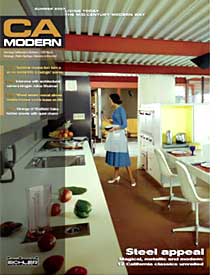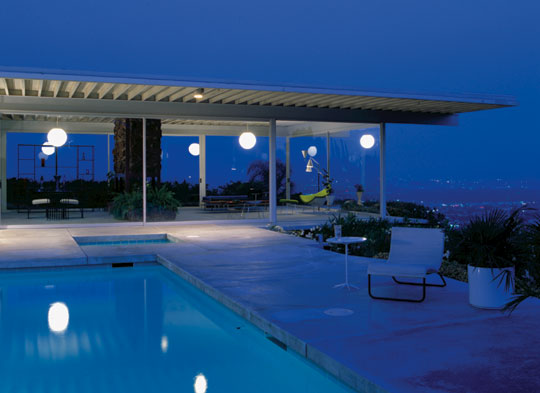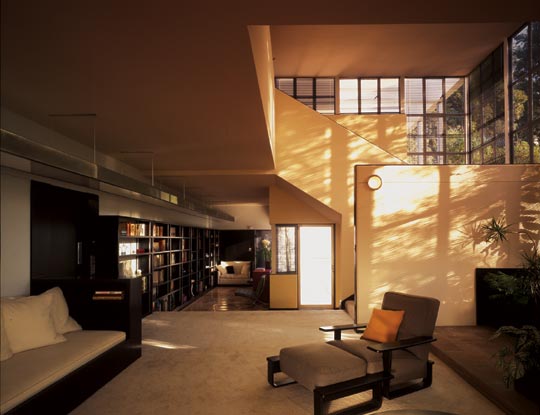Steel Houses: Steel Ideal

Steel can do so much. It can span great distances, and surge outwards into the open air with no apparent means of support. It can withstand desert heat and mountainous winds. It can be as strong as Superman, yet as svelte as Lois Lane. Steel can produce houses that are box-like, pure pavilions that float above the land, or houses that burrow into their sites. Steel houses can be cool machines, or warm cabins. As a material, steel is emotionally malleable. Steel frames and panels can be prefabricated in a factory, trucked to a building site, and assembled quickly.
Historically the push for steel was part of a larger movement that sought to make houses easier to build and maintain. Designers from the 1930s on also tried plastics, aluminum, reinforced concrete, and concrete blocks. 'Arts & Architecture,' the magazine that did so much for residential steel by sponsoring the Case Study House program from the late 1940s into the '60s, bragged about steel's "permanence, its crisp fine line" in an article about Craig Ellwood's Case Study 'Fields House.'
Few architects who worked in steel ever had the primary goal of producing a 'steel house.' Designing a house, most of them will surely admit, is not about the material that is used, but about serving the needs of the people who live there.
A close look at a dozen of California's most distinguished modern steel houses shows how their architects addressed those needs and the variety of approaches they used to reach that goal.
#1: Stahl House - Case Study House 22
Built: 1960
Architect: Pierre Koenig
Where: Hollywood Hills
Status: This iconic home remains in-demand for high style photo shoots.
Structure: Steel frame, with exposed ceiling of steel decking. The roof is covered with composition roofing and gravel. Walls are glass and steel decking. Interior walls are faced with insulated wallboard. Steel caissons support the house, on a steep and tricky site.

The steel roof beams draw the eye towards the view, as though any drawing is needed. The Stahl house is one of the most famous modern homes anywhere, thanks to Julius Shulman's classic shot of well-dressed partygoers enjoying cocktails in a glass box floating above the lights of Los Angeles.
The steel allowed Koenig to create a house that appears almost immaterial. Inside, nothing is allowed to block views—not suspended kitchen cabinetry nor the see-through fireplace. Steel beams and decking provide south- and west-facing overhangs that control summer sun. The steel allows the house to cantilever out over a rock face towards Los Angeles, as though it is reaching for the lights of the city below.
More even than as a practical residence, the Stahl house has functioned as an iconic image of modernity, thanks to Shulman's image. Architect Norman Foster wrote of "the heroic nighttime view of Pierre Koenig's Case Study house," and said: "If I had to choose one snapshot, one architectural moment, of which I would like to have been the author, this is surely it."
Photo: David Glomb
#2: Lovell Health House
Built: 1929
Architect: Richard Neutra
Where: Los Angeles
Status: The home remains in superb condition.
Structure: Steel frame encased in concrete, with plastered interior walls of metal lath.

The granddaddy of California steel houses, Neutra's Lovell Health house set the scene for much that followed. Almost certainly the first steel-framed modern house in California, the Lovell house is framed in off-the-shelf steel posts and beams, with 12-inch steel wing plates at junctures for lateral strength. Window casements are steel.
Like so many California steel houses that followed, the Lovell house used steel to handle a steep slope. The house's distinctive cantilevers are suspended from the roof. Unlike most of the steel houses, the Lovell uses steel for interior partitions—as a steel mesh encased in plaster. But with its shot-on stucco exterior, it looks less like a steel house than like concrete floating atop glass walls. The steel is implied.
The result, according to a fan, British architect Terry Farrell, is a home with "all the glamour of Hollywood and the West Coast."
Photo: Tim Street-Porter




